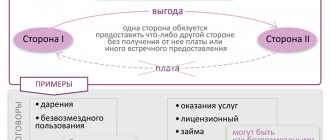Concept and subject composition
Investment activity involves the use of financial resources or property to contribute to the development of a project with the aim of subsequently making a profit.
The areas in which investor resources are invested can be varied and affect the field of construction, reconstruction of facilities, acquisition of equipment, restoration and purchase of production equipment. The subject matter of the agreement is diverse: an investment agreement may include the following types of parties:
- legal entities;
- state and municipal enterprises;
- individuals;
- foreign legal entities.
Legal relations regarding investment are regulated:
- Federal Law of December 30, 2004 No. 214-FZ;
- Civil Code of the Russian Federation;
- Federal Law of February 25, 1999 No. 39-FZ.
Despite such a number of legal acts, the legislation does not provide a precise definition of what an investment agreement is, therefore, in practice, both the concepts of contract and agreement are used.
There is no direct legislative restriction on concluding transactions between individual entities. Legal relations between any of the above types of groups are possible: for example, an investment agreement between an individual and a legal entity can be concluded for the purpose of the individual’s contribution to construction in order to subsequently obtain living space in the constructed house. The conclusion of agreements between government agencies and legal entities can be carried out for the purpose of creating or reconstructing enterprises as part of the implementation of federal programs.
Calculation of financial results
The calculation of the financial result is prescribed in a special form approved by Order of the Ministry of Finance dated June 13, 2012 No. 77. The form contains the following items:
- TIN of the partnership, checkpoint.
- Correction number.
- Reporting period.
- Date of application.
- Name of the IT contract.
- Contact number.
- Indicators from the calculated amount: income from disposal, acquisition costs, profit, loss, etc.
The form for calculating the financial result can be found on the Internet.
Features of the investment agreement
The lack of a legally established legal structure of an investment agreement makes it difficult to distinguish it from other types of transactions. In comparison with preliminary agreements of purchase and sale, contract, provision of services, loan, an agreement on investment in a business has similar features. What makes investment deals different from others?
The distinctive features of the contract in question are:
- intended use of the provided funds (when concluding an agreement, the investor determines the area and limits of use of the provided resources, information about this is contained in the project);
- special taxation regime (property received as part of such transactions is not subject to VAT, this provision is established by paragraph 4 of Article 39 of the Tax Code of the Russian Federation and is confirmed by judicial practice - see the resolution of December 4, 2006 in case No. A74-1479/2006-F02 -6502/06-С1);
- insurance of funds used by the investor (if an agreement is concluded on the implementation of investment activities with the participation of state and municipal bodies, it is necessary to use an insurance instrument. The main document regulating the legal relationship for insurance of investments is Decree of the Government of the Russian Federation dated November 22, 2011 No. 964);
- the use of multiple connections in the subject structure (the investor enters into an agreement with an investment company that hires a contractor to build an object. After the object is put into operation, it will be used by the company, for which it will pay money to the investor).
Project price
The agreement with the investor must have a price clause. The investor is interested in a fixed price, that is, a price that will not change for the duration of the project. It takes into account such nuances as the customer’s remuneration for the work done, the cost of materials for the work, the cost of services provided by qualified specialists, possible risks, and payment for the use of certain equipment.
The approximate price is determined in accordance with the established procedure, that is, this point must be specified in the contract. The index method is mainly used for calculation. This method provides that each of these costs is adjusted by indexes, taking into account any changes in the prices of materials and services used.
The term of the contract also plays an important role in determining the cost of the project. In many cases, it is the deadline that serves as the starting point for determining further liability. As practice shows, violations of obligations are allowed within the deadline for completing design work. If the property is not delivered on time, changes in price are possible. Not only the investor is at risk, but the customer himself is at risk. The investor's risk is that he does not receive the result on time and this can ruin all his plans (sometimes they invest in real estate for subsequent sale, while he can enter into an agreement with a potential buyer). The customer risks that the investor may sue or the cost of materials or services may increase in price and this will provoke a shortage. This situation can take away the customer’s income.
Agreement structure
The document signed by the parties is drawn up in two copies. Let's consider the structure of the contract using the example of an investment transaction for construction. The document must include the following sections:
- Subject of the transaction. It is indicated what the investor is allocating funds for, and at what result the goal is considered achieved; concluding investment contracts for construction requires a precise definition of the subject, for this the following data is indicated: area, address, number of floors, intended purpose.
- Characteristics of the construction project: presence of encumbrances; cadastral numbers of land plots where development is taking place; price; category.
- Property rights to the results of the project. The type of right for the investor is established: lease or ownership; share size.
- Obligations of the parties. Mutual responsibilities for paying fees, preparing projects, deadlines for completing work and making payments, and the obligation to insure the facility are determined.
- Financial conditions. The volume of investments for the implementation of the project is indicated; types of investment are established: cash, property, rights.
- Liability: the investment agreement may, but is not required to provide for this, and in the absence of it, the general provisions of the law will be applied: for example, Art. 17 Federal Law of February 25, 1999 No. 39-FZ.
- Final provisions. The number of signed documents is indicated; duration of the contract; procedure for transfer of rights.
- Details and signatures. Individually identifying data is recorded: INN, OGRN, address, name of the parties to the transaction; Full name is indicated. the signatory and the signature is affixed.
Execution of the transaction
I will not comment here on the rather simple process of signing documents for an investment transaction; I will only note a couple of important points that are worth paying attention to at this stage.
As I already noted, only the minutes of the general meeting of participants on increasing the authorized capital of the company are subject to notarization within the framework of an investment transaction; other documents are drawn up in simple written form.
However, if we talk about an option for a share in a company, it is also notarized, since it provides for the alienation of a share in the company. I didn’t just talk about options in this section of the article. Registration of an option as part of an investment transaction is increasingly becoming relevant, because it is directly related to the investor’s fulfillment of his obligations.
Often, investors transfer investments in tranches, but at the same time acquire the entire stake in the company at once . In such situations, there is a risk that the investor, already owning the entire share in the company, for some reason will stop transferring tranches. I analyzed a similar case in some detail in this article, this really happens and for such cases it is better to prepare an option in advance.
The option allows, if the investor is late in the next tranche, to take away the latter’s entire share out of court and thereby remove him from the company, subsequently offering his share to a new investor to close a possible cash gap, which often arises in such cases.
The option is convenient because to execute it, you just need to correctly specify the cases in which it will “work.” So, if we protect against investor delays with an option, then we stipulate in it that if the investor is late in the next tranche (the payment schedule is usually indicated in the investment transaction itself), the founder has the right to take the investor’s share for a fee/free of charge. In order for this to happen, the founder, after a delay occurs, takes a bank account statement, certifies it with the signature of a bank employee (and the bank’s seal), and comes with the specified document and option to any notary (although it is better to go to the notary who initially the option was issued), presents them to the notary and, after checking them, the notary signs an acceptance, on the basis of which the notary, executing the option, sends an application in form P14001 to the tax office to register the relevant changes in the Unified State Register of Legal Entities.
Transferring an object
If we take the real estate sector as an example, then after a person owns the right to lease land, he undertakes to obtain permission to put into operation this building complex.
It is important to take into account the fact that the lease agreement must also be valid for the period when the construction work is already completed. Otherwise, the built house will be considered as built without the knowledge of the owner and such a house will be subject to demolition. And if there is no lease document, investors can appropriate it for themselves without the knowledge of the customer. Of course, there will be an opportunity to return it back, although it will be quite difficult to do this. The procedure for transferring an object:
- the customer obtains permission to put it into operation; the house must be registered in the state management register;
- after registration, the customer notifies the customer in writing of his readiness to transfer ownership of the object, sets a time and date for the transfer, where everything will be legally formalized;
- After the investor has inspected the property and found that there are no defects, he signs the transfer and acceptance certificate, and then goes to the state registry office to register the premises as his property.
In any case, there are risks that the parties to the investment agreement are wary of, the main ones being:
- The premises have been redeveloped. This incident was not reflected in the contract. One of the parties is not aware of the changes;
- The customer does not have ownership of the land. Such construction will be declared invalid and the house will not be put into operation;
- The object does not meet the characteristics that are clearly stated in the contract;
- The area of the premises is smaller or larger than that specified in the contract;
- The construction of the facility was not carried out with high quality, there are deviations from established standards.
Underwater rocks
In any case, the investor bears the greater risk, since his financial capital is involved in the project. An investor should be wary of many things and before investing money in a business, it is necessary to collect information regarding the customer.
Experts advise the following:
- Initially, it is worth checking the business reputation of the customer’s company, including their credit history;
- Be sure to request from the organization the title documents for ownership of the land; most often this document will be a passport;
- Request from the customer all permitting documents for carrying out design work. Make sure that there are no expired permits and that there will be no problems with documentation in the future;
- If there is already an investor, then it is worth conducting a legal examination of the business relationship between them. After that, request a contract and attach them to the new one.
So, an investment agreement is a very important decision for the customer and investor, which must be carried out with a full package of documentation and information. Each participant has rights and obligations, adhering to which one can hope to obtain a positive result.
- .
- .





